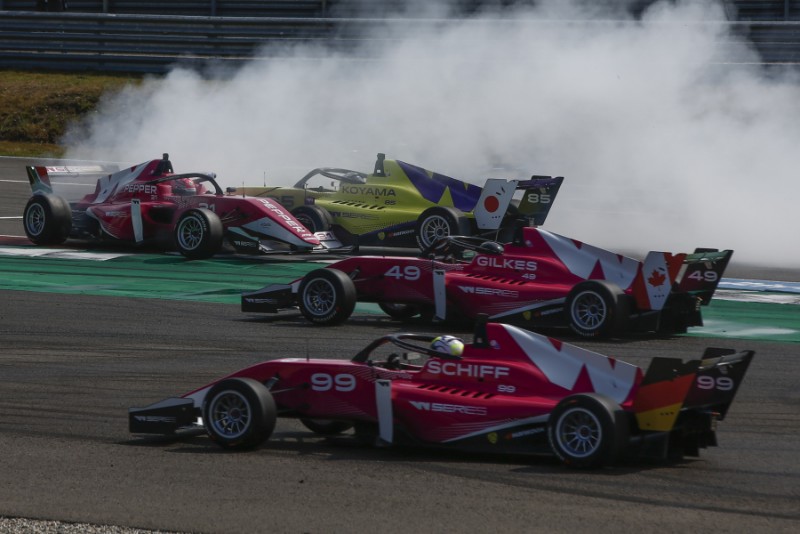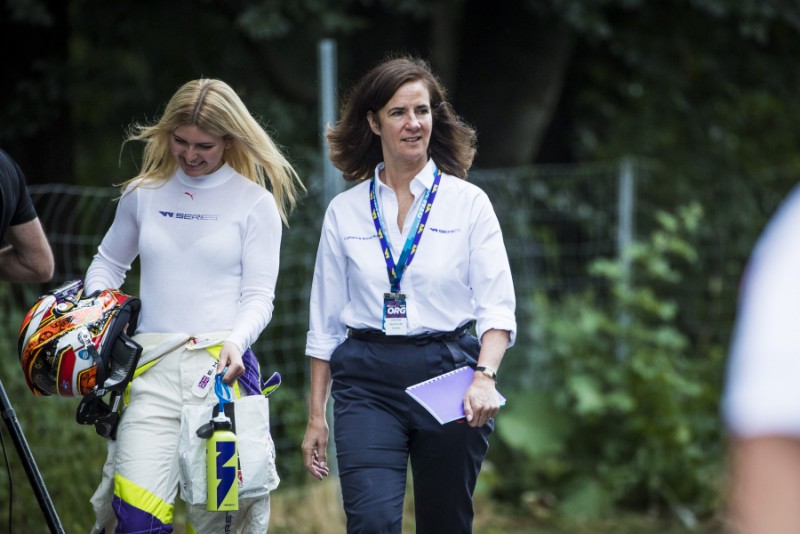
Photos: LAT Images
W Series shook off many of its doubters after its first race at Hockenheim. As it approaches the end of its first season, its management team tells Formula Scout its thoughts on season one and the future
It’s fair to say that W Series, possibly the most highly scrutinised single-seater series outside of Formula 1, has received criticism of some kind for every decision it has made. This is a side effect of what its communications director Matt Bishop, a former F1 journalist and PR, puts down to “punching way above our weight in terms of the noise we can make in comms, PR, and social media, with a diversity dividend thrown in [too]”.
F1 markets itself as the pinnacle of motorsport, and most junior series fashion themselves as talent factories for F1’s future. In recent years, the global sanctioning body has taken that idea in-house with the ‘FIA Global Pathway’ from karting to F1.
There has been well-founded criticism of that model, but its attempted ‘decluttering’ is generally in line with what competitors want to see. Which is why W Series, which uses Regional Formula 3 cars, and its divergent strategy has ruffled feathers.
“We want to make a difference. We?re deliberately disruptive. We want to drive more and more women into race cars, and we want W Series to be successful in its own right,” Bishop explains to Formula Scout.
“We want our best drivers to go into more senior single-seater formulae, or indeed other categories, as we have drivers whose ambition is to race at Le Mans or IndyCar.

“If somebody wanted to race in FIA Formula 3 or Indy Lights – and they?ve carved out a future so their destination is F1, IndyCar, World Endurance Championship etc. – we?d utterly support it and say: well done, it was great having you, bon voyage and remember where you learned to be such a good racing driver. We?ll be there when you finally make it and be thrilled to bits.
“That?s our mission, so that?s why I always think some of the criticisms we?ve had are so unfortunate and perhaps misguided.”
Driving standards differs greatly in the W Series field, and the fact that the manufacturer-backed Jamie Chadwick and Beitske Visser – both experienced in F3-level machinery – will be fighting for the title at Brands Hatch is no surprise.
Bishop’s argument stands up when you look at the non-championship reversed grid race at Assen. Megan Gilkes, the youngest and most inexperienced W Series driver, started from pole as a result of being last in the standings, and then held off continuous pressure for a remarkable win by 0.003 seconds.
Earlier in the season, Gilkes had been demoted to ‘reserve driver’ status for her poor performances, and her redemptive Assen win demonstrated her learning curve. Even better for Gilkes, track time in the W Series is totally free for the drivers.
Despite a multi-stage driver selection process, W Series was called out for putting drivers with little experience of downforce straight into F3 cars, not least after Gilkes crashed heavily into Emma Kimilainen at Hockenheim, leading to the latter missing two rounds with injury.

A fleet of Formula Renault 3.5 cars was under consideration at one point, with W Series deciding on Tatuus’s T-318 as it believed it would challenge the top drivers it would likely attract, while also being driveable for its backmarkers. Having F3 cars aesthetically similar to modern F1, and decked in fluorescent colour schemes, also of course helped with the show.
“The key thing about W Series is getting bums on seats and on television, we pushed hard on that. We?re live and free – the only [motorsport] series on the first five UK channels. That’s why our races are half-hour plus one lap, neat for a one hour television programme.”
The secret driver selection process was also ran with TV in mind, introducing the drivers that fans would get to know over the season. Once again, thinking about how to increase engagement and inspire the next generation of racers.
With the top 12 in the final standings returning for next season, where it will once again be on the DTM support package and have a live TV slot, it’s likely that the W Series field will become recognisable in its own right. This blend of racing and entertainment, which Formula E successfully harnessed first, and its undecided FIA superlicence status, raises the question whether W Series is a junior series in the traditional sense at all. W Series’ racing director Dave Ryan has the answer.
“Within reason we can do anything we want. We don?t have to accept what is sort of accepted as the norm. We can look at it and go: that works, but actually it only works because that?s what everyone expects,” says Ryan, who was previously sporting/racing director at the McLaren and Manor F1 teams.

Matt Bishop (l) and Dave Ryan (r)
“That?s the safe approach.? But actually if we stand back and look at it from a punter?s point of view and a TV point of view, as long as we don?t come up with gimmicks and as long as whatever we come up with the best driver prevails over a course of season, why wouldn?t you look at [experimenting]? It doesn?t mean you have to adopt it, but at least we can look at it and talk about it and try to understand it and do some simulations and approach things in a slightly different way.”
W Series’ first experiment was the reversed grid Assen race, which DTM pushed for given W Series’ effect on its ticket sales, and was considered a success by drivers and punters. Its accommodation into the 2020 season sits on whether it can also feature on TV, and it would not necessarily take on the format trialled at Assen.
Beyond its DTM support slot, W Series is aiming for at least one race apiece in Asia and North America by 2021.
While the ‘traditional’ medium of television has been the focal point of the inaugural W Series season, it’s limited in its ability to “get more women in race cars”. Promoting grassroots participation is the next stage of W Series’ plan according to Bishop, who says such initiatives haven’t begun yet “because we?re in year one of a start-up” and “you have to learn to walk before you can run”.
“But all of those things are in planning. We hope that our drivers will become role models so that young girls – I?m talking about eight year olds – rather than asking their parents for a pony they?ll ask them to buy a go-kart. That will cause a organic change. We?re already seeing young girls getting excited and saying: I want Jamie Chadwick to win, or I want to be like Beitske Visser. That kind of thing is happening already.
“Over time, we would like to perhaps get more involved in active grassroots support and indeed STEM initiatives. And CSR, corporate social responsibility. We have hopes that we might be able to take W Series into schools, colleges and universities to explain to young women that you can be a racing driver if you?re a woman, our drivers have shown that, but also encouraging women to get involved in motorsport at all levels and in all disciplines.”

If W Series can take a one-to-one message to young people who want to find out how to start in karting or engineering, that can only be a good thing for motorsport.
All of these ideas cost money, and W Series is currently financed by investors. With womens’ sport currently being a boom area for business though, the championship thinks its “on the zeitgeist” to bring in substantial sponsorship for the 2020 season.
The largest single investor at present is?Sean Wadsworth, a childhood friend of former F1 driver David Coulthard – who brought former McLaren colleagues Bishop and Ryan on board and struck TV deals via his own production company. While these four have been involved for the last year, the idea for W Series preceded them and came from Catherine Bond Muir.
“Catherine had the idea,” recounts Bishop. “She quit her job as a sports lawyer, had never worked in motor racing but always loved it. She was involved in the team of lawyers that sold Chelsea Football Club to Roman Abramovich.
“She?s worked at a high level with a lot of money around law and corporate finance in sport. She has all that background which is very good because Dave and I don?t have that.
“Catherine was in her 40s but just had a baby, and began to think about W Series during her maternity leave. She assembled the beginnings of our team in early 2018, but had been at it already for two years without taking a single cent in salary.
“It was her brainchild. She deserves the credit, and in fact I think she deserves to be Dame Catherine at some point, and I wouldn?t be that surprised if she becomes it.?Arise, Dame Catherine (for services to women in motorsport).”

The unique way W Series operates on a race weekend
Besides the more obvious ways in which W Series differs from other series, one of the most important is that the cars are centrally ran by FIA F3 Championship team Hitech GP. In his role as racing director, this supplies Ryan with unique challenges.
“My job is all about making sure it all happens, really,” confesses Ryan.
“We?ve got plenty of good people, and if they all do their job as they?re supposed to do it then it will all go fairly smoothly.
“Obviously it?s a new setup, there will be new challenges. At Assen we had a bit of a screw-up with some of the timings for driver briefings. The drivers dropped off a bit and were not turning up when they should be. When they do turn, another meeting?s overrun [as a result]. That shouldn?t happen.
“It?s just learning how to deal with those things, because that interrupts the flow of everything. People get frustrated for no real reason.? It?s a case of understanding that timing?s important, and if people do their job then everyone else can do theirs too.
“[Being centrally run] means you can go a long way to guaranteeing a level playing field for the drivers, which is what we set out to achieve. But it is quite a challenge. You?ve got two free practice sessions. We had 20 cars out there, getting everyone in the right place in the right time in an organised manner [was hard]. Dan Hodder and his Hitech guys are doing a fantastic job on that front. Because you have to.
“It?s one thing being in a team of two drivers and chasing them around, but with 20 drivers it?s a lot bigger deal.”

The British Racing & Sports Car Club, also responsible for Britain’s national Formula Ford championship, stewards the championship and provides scrutineers. While it’s highly unlikely, it has the power to penalise Hitech were there to be an infraction in the way one of the cars was set-up.
Mistakes have been made though, and Alice Powell has been on the receiving end of bad luck this year through crashes and failures.
“Crashes happen, don?t they. You can look at both of those incidents she was involved in, and you can attribute blame to one driver or the other. And that?s fair – but she did have a gearbox issue [at the Norisring].
“The gearbox itself wasn?t at fault, but we perhaps introduced a fault into it.?These things happen, and unfortunately for Alice she was on the wrong end of it. It was a problem we perhaps should?ve picked up earlier and we didn?t.”
W Series’ structure, where all drives are fully paid for, means it can rotate promote and demote drivers to and from reserve roles. Some of these decisions have appeared hasty, given they’ve been announced after free practice has taken place.
“We try to be flexible and we try to be fair,” Ryan says in defence of W Series’ previous decisions, which he denies were made last-minute.
“To be absolutely honest, you look at our reserve drivers and you look at our race drivers, and you could argue that some of the reserve drivers should be racing and some of the race drivers should be reserves.

“We decided on the strategy this season, we?ve tried to be flexible on it but at the same time we have to adhere to our regulations and what have you so we can only work within that. Maybe we need to look at that for next season, see if we can change it to make it a little bit easier to apply – I don?t want to use the word fairness – to make it more equal in how we run the reserve drivers.”
Changes in the way reserve drivers are rotated will be on the agenda when W Series reviews in-depth its first season.
“One of the great things about being centrally-run: we control everything. It means we can be honest with ourselves at the end of it and sit back and say: you know what, that worked and that didn?t work. How do we change that? How do we make it better?
“As long as we?re completely honest and prepared to take honest open criticism, we can just improve the show as we go along. That?s kind of unique. We?re in control of our destiny, as long as we fulfil all our obligations to the FIA and governing bodies, we?re in the unique position where we can kind of change strategies, we can do thing a bit different.
“We can look at avenues that perhaps other championships can?t look that. It?s a question of being able to look at everything, and changing if we need to.”